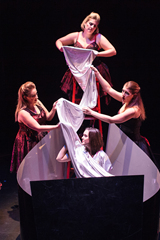| Opera Reviews | 12 May 2024 |
Eat, drink and be marriedby Steve Cohen |
|
| Sokolovic: Svadba - Wedding Opera Philadelphia November 2013 |
|
|
This follow-up to Stravinsky's 1913 Le Sacre du Printemps was a choral composition using Russian peasant folk songs about weddings, much of the text stressing a woman's duty to marry, and marriage's restrictive aspects. In 2011 the Serbian-Canadian composer Ana Sokolovic created a Balkan version of the same subject, titled Svadba - Wedding. Her text is based on the folk traditions of various countries in the region, primarily her native nation of Serbia. Here, as in the Stravinsky, we hear the anxiety of leaving behind one's freedom. There's one significant difference between the Stravinsky and the Sokolovic. The Russian composer wrote a score for four pianos plus seventeen percussion instruments. (The American premiere used composer-pianists Aaron Copland, Marc Blitzstein, Louis Gruenberg and Frederick Jacobi, conducted by Leopold Stokowski). Sokolovic, on the other hand, has her vocalists sing virtually a capella, with only an occasional ocarina, rainsticks and glockenspiel to add color. Also, Stravinsky covered an entire wedding while Svadba concentrates on a bachelorette gathering on the wedding's eve. The bride Milica is surrounded by her girlfriends, preparing her hair and dress, remembering their happy times and expressing sadness about the changes to come. Les Noces used solo vocalists plus sixty dancers while Svadba has six singers provide all the physical movements. As they traveled to varied positions on the wide stage they stayed remarkably together in their harmonizing and in the details of their contrapuntal interplay. Sopranos Jacqueline Woodley, Shannon Mercer, Virginia Hatfield and Laura Albino, and mezzo-sopranos Andrea Ludwig and Krisztina Szabó were the superb ensemble. All of them have backgrounds in opera roles yet they were totally believable as Balkan peasant women. Much of their music was mesmerizingly soft and lovely; other parts used glottal stops and guttural trills as one often hears in African and Arabic cultures. Keep in mind that Islam has a strong following in the Balkans, especially in Bosnia, and a third of the area's Roma (gypsy) people are Muslim. Dáirine Ní Mheadhra conducted commandingly and Marie-Josée Chartier directed, as they had at the work's premiere in Toronto in 2011. After the 50-minute performance, a ten-person Balkan orchestra (led by tuba and baritones) came onstage and started a procession towards a wedding party in an adjoining room, featuring traditional cuisine and dancing. This was the first in Opera Philadelphia's new Opera in the City series, intended to show untraditional operas in unusual venues. |
|
| Text ©
Steve Cohen Photo © Dominic M. Mercier |

 It
was exactly one century ago that Igor Stravinsky started writing The
Wedding, titled Les Noces in French, the language which Stravinsky
was using at that point in his life. (The premiere was given by the
Ballets Russes in Paris.)
It
was exactly one century ago that Igor Stravinsky started writing The
Wedding, titled Les Noces in French, the language which Stravinsky
was using at that point in his life. (The premiere was given by the
Ballets Russes in Paris.) 





